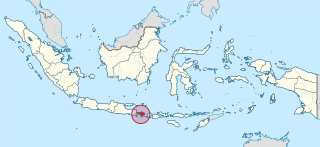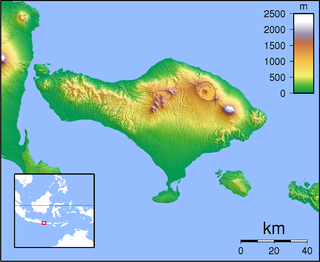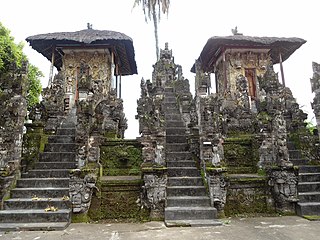
Bali is a province of Indonesia and the westernmost of the Lesser Sunda Islands. East of Java and west of Lombok, the province includes the island of Bali and a few smaller neighbouring islands, notably Nusa Penida, Nusa Lembongan, and Nusa Ceningan to the southeast. The provincial capital, Denpasar, is the most populous city in the Lesser Sunda Islands and the second-largest, after Makassar, in Eastern Indonesia. The upland town of Ubud in Greater Denpasar is considered Bali's cultural centre. The province is Indonesia's main tourist destination, with a significant rise in tourism since the 1980s. Tourism-related business makes up 80% of its economy.

Denpasar is the capital of Bali and the main gateway to the island. The city is also a hub for other cities in the Lesser Sunda Islands.

Balinese Hinduism is the form of Hinduism practised by the majority of the population of Bali. This is particularly associated with the Balinese people residing on the island, and represents a distinct form of Hindu worship incorporating local animism, ancestor worship or Pitru Paksha, and reverence for Buddhist saints or Bodhisattava.

Walter Spies was a Russian-born German primitivist painter, composer, musicologist, and curator. In 1923 he moved to Java, Indonesia. He lived in Yogyakarta and then in Ubud, Bali starting from 1927, when Indonesia was under European colonial rule as the Dutch East Indies.

The Klungkung Palace, officially Puri Agung Semarapura, is a historical building complex situated in Semarapura, the capital of the Klungkung Regency (kabupaten) on Bali, Indonesia. The palace (puri) was erected at the end of the 17th century, but largely destroyed during the Dutch colonial conquest in 1908. Today the basic remains of the palace are the court of justice, the Kertha Gosa Pavilion, and the main gate that bears the date Saka 1622. Within the old palace compound is also a floating pavilion, the Bale Kembang. The descendants of the rajas that once ruled Klungkung today live in Puri Agung, a residence to the west of the old palace, which was built after 1929.

Sanur is a coastal stretch of beach east of Denpasar in southeast Bali, which has grown into a little town in its own right. A 5.1 km (3.2 mi) area of Sanur's coastline, from Matahari Terbit Beach to Mertasari Beach, was reclaimed in 2008.

Mads Johansen Lange, nicknamed the King of Bali, was a Danish trader, entrepreneur, peace maker on Bali, knight of the Order of the Netherlands Lion, and recipient of the Danish gold medal of achievement. He was the son of Lorents Lange Pedersen and Maren Lange, a merchant and a merchant's daughter, respectively.

Puputan is a Balinese term for a mass ritual suicide in preference to facing the humiliation of surrender. It originally seems to have meant a last desperate attack against a numerically superior enemy. Notable puputans in the history of Bali occurred in 1906 and 1908, when the Balinese were being subjugated by the Dutch.
Gelgel is a village (desa) in the regency (kabupaten) of Klungkung, on Bali, Indonesia. The village, near the coast four kilometers south of the regency capital Semarapura, contains a number of structures of cultural interest, and is known for its pottery and handwoven ceremonial songket cloth. The height of the village's power came during the kingdom of Gelgel, which dominated Bali from around the early 16th century to 1686. There are no traces left today of the old royal palace (puri). The old ancestral shrine of the ruling dynasti, Pura Jero Agung, is still standing in the old palace area. To the east of Pura Jero Agung is another old temple, Pura Dasar, which is a lowland counterpart of the "mother temple" of Bali, Pura Besakih. The village also contains the oldest mosque in Bali, which was built by Javanese retainers of the old kings.

Dewa Agung or Deva Agung was the title of the kings of Klungkung, the foremost in rank among the nine kingdoms of Bali, Indonesia. It was also borne by other high-ranking members of the dynasty. The term Dewa means "god" and was also a general title for members of the Ksatria caste. Agung translates as "high" or "great". Literally, the title therefore means Great God.

The Dutch intervention in Bali in 1908 marked the final phase of Dutch colonial control over the island of Bali in Indonesia. It was the seventh and last military intervention in Bali, following the Dutch intervention in Bali (1906).

The Dutch intervention in Bali in 1906 was a Dutch military intervention in Bali as part of the Dutch colonial suppression, killing over 1,000 people, most of whom were civilians. It was part of the Dutch campaign for the suppression of most of the Netherlands East-Indies. The campaign killed the Balinese rulers of Badung and their wives and children, as well as destroying the southern Bali kingdoms of Badung and Tabanan and weakening the kingdom of Klungkung. It was the sixth Dutch military intervention in Bali.

The History of Bali covers a period from the Paleolithic to the present, and is characterized by migrations of people and cultures from other parts of Asia. In the 16th century, the history of Bali started to be marked by Western influence with the arrival of Europeans, to become, after a long and difficult colonial period under the Dutch, an example of the preservation of traditional cultures and a key tourist destination.

The Dutch intervention in Northern Bali in 1846 was the first in a long series of Dutch military interventions on Bali island, until total control was achieved with the Dutch intervention in Bali in 1908. The Dutch used as a pretext Balinese salvage claims over shipwrecks, which were customary to the Balinese, but unacceptable to the Dutch.

The Dutch intervention in Bali in 1849 was a major Dutch military intervention in Northern and Southern Bali, following two failed interventions, the 1846 intervention and the 1848 intervention. The Dutch used as a pretext Balinese salvage claims over shipwrecks, which were customary to the Balinese, but unacceptable under International law.
I Gusti Ketut Jelantik (-1849) was a Balinese Prime Minister of the state of Buleleng, who resisted the imposition of Dutch treaties.

The Dutch intervention in Lombok and Karangasem took place in 1894, and is part of the string of Dutch interventions in and around Bali that led to complete colonization of both Bali and Lombok by the early 20th century.
The Blambangan Kingdom was the last Javanese Hindu kingdom that flourished between the 13th and 18th centuries, based in the eastern corner of Java. The capital was at Banyuwangi. It had a long history of its own, developing contemporaneously with the largest Hindu kingdom in Java, Majapahit (1293–1527). At the time of the collapse of Majapahit in the late fifteenth century, Blambangan stood on its own as the one solitary Hindu state left in Java, controlling the larger part of Java’s Oosthoek.

The Kingdomship of Bali was a series of Hindu-Buddhist kingdoms that once ruled some parts of the volcanic island of Bali, in Lesser Sunda Islands, Indonesia. With a history of native Balinese kingship spanning from the early 10th to early 20th centuries, Balinese kingdoms demonstrated sophisticated Balinese court culture where native elements of spirit and ancestral reverence combined with Hindu influences – adopted from India through ancient Java intermediary – flourished, enriched and shaped the Balinese culture.

Pura Dalem Segara Madhu also known as Pura Dalem Jagaraga is a northern Balinese Hindu temple or pura located in the village of Jagaraga, Buleleng in northern Bali. It is about 11 km east of Singaraja. The village of Jagaraga is known historically as the place where the Dutch colonial government witnesses puputan or Balinese mass-suicide following their military attack on the kingdom of Bali in 1849. Pura Dalem Segara Madhu is known for its intensive wall decoration typical of northern Balinese architecture and for its unique western-influenced relief e.g. motifs of early 20th-century airplanes and automobiles.


















